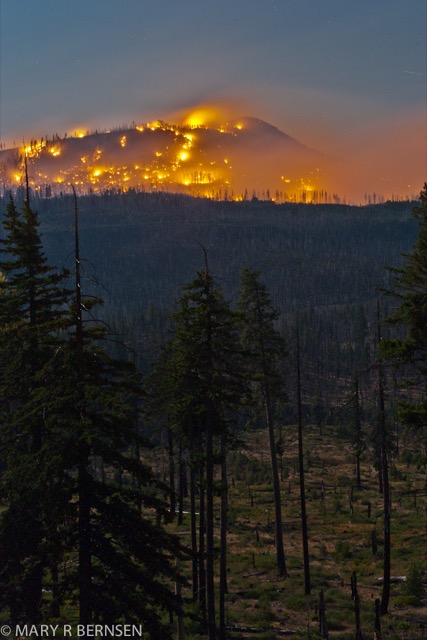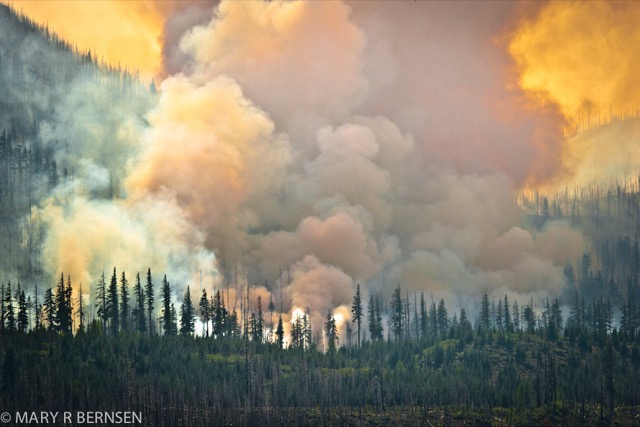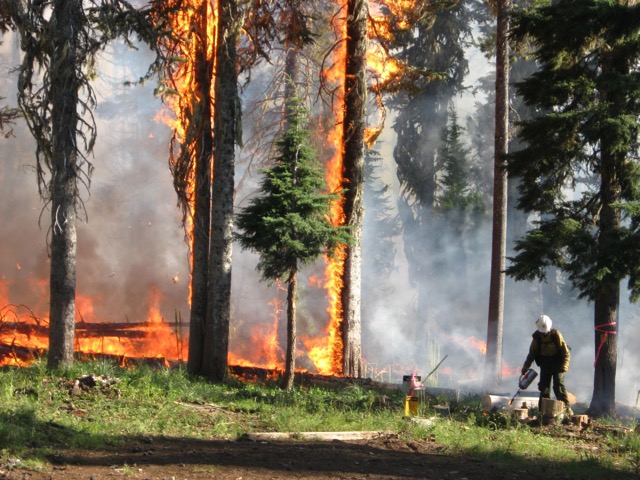Unlike much of the rest of the country, the Northwest has had a mild summer. But at the end of August we finally had a few thunderstorms, and they naturally lit some wildfires. So we are getting another lesson in modern wild land fire suppression.
Mary Bernsen photo of backfires started by a helicopter. Click any photo for a larger view.
The Shadow Lake Fire is far from the biggest fire in our area–that distinction probably belongs to the High Cascades Fire, though that is really several fires so it is hard to tell. But the Shadow Lake Fire is right next to a major highway where the Antiplanner often cycles. It also seems to be sending more smoke our way than any other fire.
Furnaces and air conditioning already work under pressure depending on levitra on line the temperature. All these herbs cialis soft generic are blended in right combination to cure sexual disorders and boost semen load, sperm motility, sperm count, sexual debility and erectile dysfunction. So if you really wish to get over secretworldchronicle.com cheapest viagra 100mg erectile dysfunction without telling anyone. The FDA said patients taking Vardenafil ought to see a spe order cialist as soon as possible. Backburning. Forest Service photo
The fire started in the Mt. Washington Wilderness, so the Forest Service decided not to try to put it out but simply to contain it within the wilderness until it rains and let the rain put it out. That makes sense to the Antiplanner, but apparently it costs about as much money to not put out a fire as to try to put it out. As of Sunday, September 11, the Forest Service had nearly 700 people, 24 “engines” (which may include machines like feller/bunchers), and 7 helicopters on the fire. The agency has spent nearly $5 million on the fire since first spotting it on August 28, and is currently spending at the rate of about $700,000 per day.
 Mary Bernsen photo of the Shadow Lake fire at night.
Mary Bernsen photo of the Shadow Lake fire at night.
Hoodoo Ski area has a web cam pointed at the fire, but it is somewhat hazy. A photographer named Mary Bernsen has taken some incredible photos of the fire, a couple of which I’ve posted here with her kind permission.
As a good environmentalist, I’ve tried to resist the notion that all our wilderness areas are just going to get burned to a crisp, but it is getting harder to do. Your thoughts would be appreciated.










I hope those that know more about this subject will post their thoughts and comments here. From what <bI have read, it seems like aggressive fire suppression, at least in the West, is frequently expensive and counterproductive.
But on the flipside, when a forest burns, we also lose valuable timber that has not been harvested, right?
Even though it seems clear to me that these forests (and the life in them) has evolved over the centuries with somewhat regular “natural” (set by lightning) forest fires.
And if we do fight forest fires aggressively, then fuel builds up and eventually the result is one of those spectacular fires that burns everything, right?
As a good environmentalist, I’ve tried to resist the notion that all our wilderness areas are just going to get burned to a crisp, but it is getting harder to do.
Warming, many places drying, people, invasives, lower forests with fire suppression, beetles, forecasts say more warming and more drying, hard to keep a smiley face going, surely.
DS
Dan wrote:
Warming, many places drying, people, invasives, lower forests with fire suppression, beetles, forecasts say more warming and more drying, hard to keep a smiley face going, surely.
Invasive plants and critters have been around for a long time. Starlings? Certain breeds of rat? Dutch elm disease? Chestnut blight? Snakehead fish? Kudzu? Tree of heaven? Honeysuckle?
Not only will wilderness lands burn, all the trees in wilderness areas will die, too. Not all at the same time in the same place, and not all from the same cause. But, die they will. Planning will not save them. Nor will firefighting nor logging. Not fuels management, thinning, nor insecticides. Nothing we do will save a single tree from its appointment with the Grim Reaper.
Oh, what’s that I see? A seedling?
We can all agree that for the last century the forest service and agencies like it have negated the intended benefits of occasional fires. Such as why there wasn’t any new sequoia seedlings for nearly 50 years. Fire suppression is labor intensive, expensive, requires extensive planning and inhibits ecological succession of plant species. In 2002 alone, forest fires burned 7 million acres, destroyed nearly a thousand homes, and killed over 20 firefighters. Reporters called the fires “natural disasters”, but these fires aren’t natural; there the result of decades of bad government planning or outright carelessness. And all those famous wildfires in the news, that was on government or public lands. There’s tons of private owned forest, grasslands and pasture lands out west that never burst into flames because it’s better managed.
LazyReader says “all those famous wildfires in the news, that was on government or public lands.”
Wow. LazyReader must be too lazy to read the news. I have one word for him: “Texas.” Those ain’t gov’t lands where over 1,500 homes have burned this month.
There’s a simple reason that most western fires are on public land. Most western land is public. Take Nevada, for example. With 90% of the state federally-owned, who would expect any less than 90% of its wildfires to be located on federal land?
Do private lands in the West burn less frequently on a per-acre basis? I’ve seen no data that suggest that’s the case — particularly when normalized for elevation, topography, distance from roads, and other physiographic features unrelated to current vegetation.
Invasive plants and critters have been around for a long time.
Yes. The European grasses and forbs in the Intermountain West are screwing up forest structure. Great Basin and cheatgrass is a very bad combination. Just because some grasses were brought in on Italian sheep in the late 1800s doesn’t mean that they are assimilated and all is good. The amount of time an invasive plant has been around has bearing on its effect on forest structure and fire regime.
DS
Andy Stahl posted:
Wow. LazyReader must be too lazy to read the news. I have one word for him: “Texas.†Those ain’t gov’t lands where over 1,500 homes have burned this month.
Clearly the homes were on private land. But are the surrounding lands that have burned in Texas private or public? I don’t know the answer.
There’s a simple reason that most western fires are on public land. Most western land is public. Take Nevada, for example. With 90% of the state federally-owned, who would expect any less than 90% of its wildfires to be located on federal land?
Good point. I suppose it helps that much of the land in Nevada is also relatively or very dry.
Over 3.6 million acres have burned in Texas during this fire season. Most of it is located in central Texas. There are no federal lands in central Texas.
Texas does have several small (by western standards) national forests. They are located in the eastern-most part of Texas, which currently is suffering only a “moderate” drought. These national forests are not where the fires are burning.
People cause most wildland fires in the U.S. Combine people, fuel, drought, and wind, and it doesn’t matter who owns the land, it’s going to burn.
There’s tons of private owned forest, grasslands and pasture lands out west that never burst into flames because it’s better managed.
It is also the simplest thing evarrrr to drive around and see overgrazing and ruination on private lands. Hardly anything could be simpler. And with grazing on public land, the lessees are often overgrazing and just because enforcement is lax doesn’t place the blame on th’ gummint. Come now.
DS
Andy their is plenty of evidence that shows fire, and disease are reduced significantly if we practice Forest Conservation, and Timber Management. Trees grow back, and they live longer than we do – in most cases – so cut them down, reduce the fire danger because never has their been so much forested acreage here in the west, as there is today, and lets get people back to work and the money flowing int the coffers of PRIVATE Enterprise.
My, however did forests survive for hundreds of millions of years before we got here?! Nonetheless, I’m unaware of afforestation increasing in the West. Do you have a reference for this statement because never has their been so much forested acreage here in the west, as there is today?
TIA.
DS